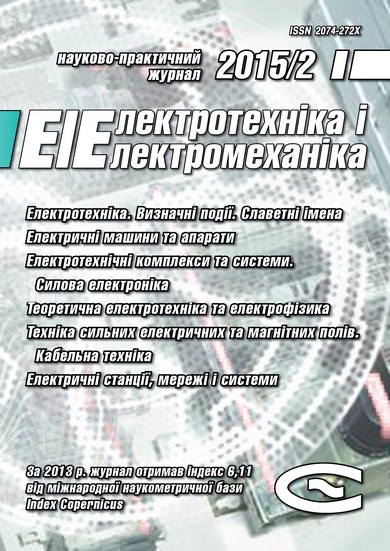THE NORMALIZATION METHODS OF THE STATIC GEOMAGNETIC FIELD INSIDE HOUSES
DOI:
https://doi.org/10.20998/2074-272X.2015.2.07Keywords:
static magnetic field, reinforced concrete structures, normalization of the geomagnetic field in the premisesAbstract
In the paper, we show the necessity of normalization of the static geomagnetic field (GMF) inside high-rise frame-monolithic houses to safe values (90% of the natural rate at least). Massive ferromagnetic construction of these buildings significantly (up to 50 %) weakens the natural GMF. The normalization methods are based on mathematical modeling of GMF in a residential area. Simplified physical models of reinforced concrete building structures are developed and used. The results of experimental studies are also used in the framework of the development of the methods. The following methods of normalization of GMF are presented and justified: 1) the use of special steel with a relative permeability less than 70 in housing construction; 2) restrictions on the use of long steel elements with the elongation coefficient in the critical range of 4<b<28; 3) demagnetization of steel reinforcement before installing; 4) preventing the magnetization of steel reinforcement in the construction process. Practical recommendations for the design of «magnetic clean» houses with comfortable living conditions in connection to the GMF are proposed.References
DBN B. 2.6698:2009. Konstruktsii budynkiv i sporyd. Betonni ta zalizobetonni konstrukii. Osnovni polozhennia [National Standard DBN B. 2.6698:2009. Construction of buildings and structures. Concrete and reinforced concrete structures. The main provisions]. Kyiv, Minrehionbud Publ., 2011. 71 p. (Ukr).
DSTU 3760:2006. Prokat armaturnnyi dlia zalizobetonnukh konstrukstii. Zahalni tekhnichni umovy [National Standard DSTU 3760:2006. Reinforcing steel bars for concrete reinforcement. General technical conditions]. Kyiv, Derzhspozhyvstandart Ukrainy Publ., 2007. 28 p. (Ukr).
Setkov V.I., Serbin E.P. Stroitel'nye konstruktsii [The building structures]. Moscow, INFRA-М Publ., 2005. 448 р. (Rus).
Rozov V.Yu., Levina S.V. Modeling of the static geomagnetic field indoor dwelling houses. Tekhnichna elektrodynamika – Technical electrodynamics, 2014, no.4, pp. 8-10. (Rus).
Rozov V.Yu., Pelevin D.Ye., Levina S.V. Experimental research into indoor static geomagnetic field weakening phenomenon. Elektrotekhnіka і elektromekhanіka – Electrical engineering & electromechanics, 2013, no.6, pp. 72-76. (Rus).
Serduk A.M., Grigoriev P.Ye., Akimenko V.Y., Protas S.V. Ecological significance of the geomagnetic field and the medical and biological conditions of hygienic regulation of its weakening in Ukraine. Dovkillia i zdorovia − Environment and Health. 2010, no.3, pp. 8-11. (Ukr).
Standard оf Building Biology Testing Methods: SBM-2008 [Acting from July 2008]. Germany: Institut für Baubiologie + Ökologie IBN, 2008, 5 p. Available at: www.createhealthyhomes.com/SBM-2008.pdf.
Rozov V.Yu., Rezinkina M.M., Dumanskiy Yu.D., Gvozdenko L.A. The study of man-caused distortions in the geomagnetic field of residential and industrial buildings and to identify ways to reduce them to a safe level. Tekhnichna elektrodynamika. Tematychnyj vypusk «Problemy suchasnoyi elektrotekhniky» – Technical electrodynamics. Thematic issue «Problems of modern electrical engineering». 2008, chapter 2, pp. 3-8. (Rus).
Pelevin D.Ye. Systemy kompensatsii tekhnohennykh spotvoren heomahnitnoho polia na robochykh mictsiakh operatyvnoho personalu elektroenerhetychnykh obiektiv. Аvtoref. diss. kand. tekh. nauk [Systems of compensation of technogenic distortions of the geomagnetic field on working places of operative personnel of electrical-power objects. Abstracts of cand. tech. sci. diss.]. Kharkiv, 2010. 21 p. (Ukr).
Ryabov Yu.G., Lomaev G.V., Kuleshova D.S. Idea of geomagnetic field recovery in screened objects. Tekhnologii elektromagnitnoi sovmestimosti – Technologies of electromagnetic compatibility, 2010, no.4, pp. 35-43. (Rus).
Rozov V.Yu., Reutskiy S.Yu., Levina S.V. The study of the effect of weakening of static geomagnetic field by steel columns. Tekhnichna elektrodynamika – Technical electrodynamics, 2014, no.1, pp. 12-19. (Rus).
Janowski B.М. Zemnoi magnetizm [Earth's magnetism]. Moscow-Leningrad, Glavsevmorputi Publ., 1941. 283 p. (Rus).
Grigor'ev B.P. Actual problems of physical field reduction of ships. Mezhdunarodnaia konferentsiia po sudostroeniiu. Trudy. Sektsiia F. Sudovaia elektrodinamika, magnetizm i gidrofizika [International Conference of Shipbuilding. Proceedings. Section F. Ship electrodynamics, magnetism and hydrophysics]. Saint Petersburg, Publishing of TsNII im. acad. A.N. Krylov, 1994, pp. 169-176. (Rus).
Horodetskii A.S., Batrak L.H., Horodetskii D.A., Lezniuk M.V., Yusipenko S.V. Raschet i proektirovanie konstruktsii vysotnykh zdanii iz monolitnogo zhelezobetona [The calculation and design construction the high-rise building of reinforced concrete]. Kyiv, Fact Publ., 2004. p. 106. (Rus).
Available at: http://www.baufritz.com (accessed 06 March 2015).
Downloads
Published
How to Cite
Issue
Section
License
Copyright (c) 2015 V. Yu. Rozov, A. V. Zavalnyi, S. M. Zolotov, S. V. Gretskikh

This work is licensed under a Creative Commons Attribution-NonCommercial 4.0 International License.
Authors who publish with this journal agree to the following terms:
1. Authors retain copyright and grant the journal right of first publication with the work simultaneously licensed under a Creative Commons Attribution License that allows others to share the work with an acknowledgement of the work's authorship and initial publication in this journal.
2. Authors are able to enter into separate, additional contractual arrangements for the non-exclusive distribution of the journal's published version of the work (e.g., post it to an institutional repository or publish it in a book), with an acknowledgement of its initial publication in this journal.
3. Authors are permitted and encouraged to post their work online (e.g., in institutional repositories or on their website) prior to and during the submission process, as it can lead to productive exchanges, as well as earlier and greater citation of published work.





